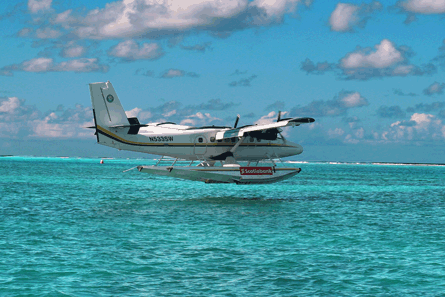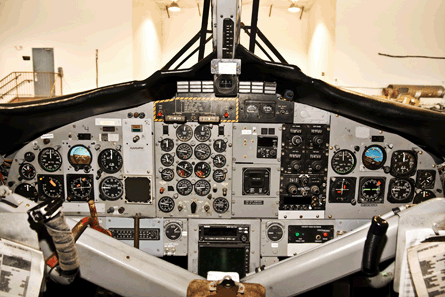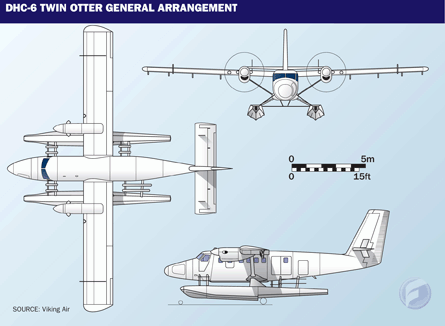Seaborne Airlines' Capt Shawn Lewis took the right seat for my familiarisation flight in the carrier's de Havilland Canada DHC-6-300, N888PV. While I had flown a wheeled Twin Otter before this adventure from the dock at Christiansted Harbor on St Croix, it was too long ago to allow me to compare performance and handling qualities.
We accomplished pre-flight checks from the dock. Other than examining the condition of the floats and ensuring they were pumped out, the inspection was like that of any other Twin Otter.
The temperature had risen to 30.6°C (87°F) under clear skies for the midday flight. Winds were from the east-south-east at 7-9kt (13-17km/h), causing 0.3m (1ft) waves in the coral reef-protected harbour.
First the right, then the left Pratt & Whitney Canada PT6A-27 engine was started using shore power. Capable of producing 680shp (505kW), the engines are flat rated to 620shp, allowing for good take-off performance under hot Caribbean temperatures.
 |
|---|
© Chris Boizel |
With pre-taxi checks completed, the dock line on the left float was released (the seaplanes are always docked with the left float). Using the overhead throttles, I eased the right engine into reverse to move the aircraft's nose away from the dock. Once angled out from the dock the aft line was released.
While still looking out of the left-hand door window I eased both power levers forward to leave the dock. The aircraft advanced as expected, but the splash of saltwater in my face was an unexpected reminder that this was a seaplane.
Reverse thrust was used on both engines to keep a taxi speed of 5-6kt. The yoke was held full forward for the taxi exercise as we sailed about the harbour. While many seaplanes have water rudders, the Twin Otter does not.
Differential thrust worked quite well in guiding the seaplane around the harbour. As with other seaplanes, the Twin Otter had a strong tendency to weathervane into the wind - handy when lining up for take-off, but a nuisance at other times. The seaplane was turned into the wind at the west end of the shipping channel in preparation for take-off.
 |
|---|
© Chris Boizel |
Using two points off the right wing I held the seaplane stationary before the power was advanced for take-off. Lewis demonstrated my first seaplane take-off and circuit to a full stop landing in the harbour at Christiansted.
Once stopped, I took control and taxied the seaplane back to the east end of the channel. Flaps were set to 20° and trim reset for take-off. A right quartering headwind required advancing the right throttle forward of the left to track the seaplane straight down the channel.
Once the rudder was effective, both throttles were advanced to 3.1bar (45lb/in2) torque. During the water run the yoke was held full forward until the seaplane settled on the first step, having risen slightly out of the water.
As the speed increased I gradually pulled aft on the yoke until the seaplane settled onto the second step, in a nearly level attitude. At an indicated airspeed of about 55kt, aft yoke pressure lifted the Twin Otter off the water. I held the seaplane in ground effect, or more appropriately water effect, for the acceleration to V1.
CLIMB-OUT
Passing 70kt, the flaps were retracted to 10°. At 86kt, Lewis called "V1" and a climb-out to 700ft pattern altitude was started. Passing 400ft the flaps were retracted and climb power set. While the aircraft was off the water before V1, had there been an engine failure before V1 we would have abandoned the take-off and set the seaplane back down on the water.
On a standard day a Twin Otter with a maximum take-off weight of 5,670kg (12,500lb) has a listed water run of 374m and a total distance of 599m to clear a 15m obstacle.
STEEP APPROACH
A JFK approach, named such as it avoids overflight of the John F Kennedy apartment complex, was flown for an east landing in the harbour. Selection of 10° of flaps caused a sizable nose-up pitch that was zeroed out with manual pitch trim. Selection of 20° and 30° flaps caused no change in trim, the Twin Otter's flap trim interconnect nicely countering pitch force changes. Power on final approach, at an indicated airspeed of 72kt, ranged from 0 to 0.69bar.
The Twin Otter is a short take-off and landing aircraft and felt comfortable at a 1,000ft/min rate of descent. During passenger operations, however, Seaborne recommends a maximum descent rate on final of 500ft/min.
 |
|---|
At roughly 10-15ft I started the round-out and retarded the throttles to idle. A touchdown attitude of about 2° nose-up was held until the seaplane settled on the surface. With both floats on the water I pulled full aft on the yoke to slow the seaplane to taxi speed.
The next take-off run was started from the point where we had stopped on the landing, after the flaps had been set to 20° and trim reset. The water run was much like my first, with the exception that slightly higher winds required the use of larger crosswind take-off control inputs.
The second splashdown was smoother than the first, with Lewis ensuring I kept the Twin Otter on top of the water. The third and final visual circuit in the harbour at Christiansted was much like the first two, with each landing slightly better than the proceeding one.
OPEN WATER
After my third take-off we headed east towards Coakley Bay to practise open water landings. As in the harbour, Lewis demonstrated the open water landing to a splash and go. We descended to a few hundred feet above the water to look for obstacles and determine wind direction and sea state.
Wind direction can be determined by reference to multiple sources: wave direction, surface wind streaks, moored boats and sea weed patterns to name a few. Winds were still from the east, but swells were markedly higher at 0.6-1m.
Lewis set the Twin Otter smoothly down on the rough water, keeping it on the step until we accelerated for the go portion of the splash and go. The sensation of skipping across the waves was not unlike riding in a very fast speed boat.
Lewis talked me through my open water splash and go, resulting is a reasonable approximation of what I had seen demonstrated by an extremely competent seaplane pilot.
Flying clockwise around the island we headed towards Frederiksted Pier, located on the west end of the island. Although instrument flight rules-equipped and qualified, Seaborne's seaplane operations are conducted in essentially visual meteorological conditions.
Seaborne has removed the autopilots in all its aircraft, and I found it relaxing to hand fly around the beautiful island. Midway around the southern side we passed a large oil refinery, the seventh largest in the world.
As we rounded the island's west tip we spied a large cruise ship docked at Frederiksted's pier, promising a large audience for splash and gos. As at Coakley Bay we descended to determine the sea state and wind conditions.
Frederiksted's pier is less sheltered than the two previous landing spots, Lewis saying the conditions were too harsh for this neophyte seaplane pilot. The sea state discussion also brought out an interesting point - Lewis said that in some cases he might be able to safely land the seaplane, while trying to get it back off the water under the same conditions might be inadvisable.
DOCKING SPEED
The remainder of the flight back to Christiansted was just as beautiful as the first part, with 0.3-0.6m waves awaiting us in the harbour. The last approach was again a JFK visual, landing in the harbour's channel.
Once safely alighted on the water I held the yoke full forward for the taxi back to the dock. Differential thrust allowed me to keep the aircraft pointed in the right direction and clear of the numerous boats in the harbour.
Approaching the dock on a reciprocal heading, I slowly swung the seaplane around to dock the left float. The smooth approach and soft docking were more the result of Lewis guiding my hands on the throttles than my limited sailing skills.
Docking and water operations are perhaps some of the more demanding aspects of being a Seaborne Airlines captain. To ensure safe operations, the upgrade to full captain is a lengthy process.
First officers are checked out in the left seat just as they are at other airlines, but the similarity ends there. Left seat qualified first officers fly under the supervision of fully qualified captains, who sit in the right seat, for anywhere from 30 to 90 days. Only after they have mastered the art of seaplane handling in tight quarters are they cleared for command in the left seat.
Source: Flight International























